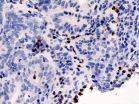(Press-News.org) Our cells must grow and divide optimally to ensure that our bodies functions properly. It is essential, however, that these processes are carefully controlled in order to prevent unrestrained proliferation that can lead to the formation of tumours. David Shore, a professor at the Faculty of Sciences, University of Geneva (UNIGE), Switzerland, and his team have uncovered a cellular factor that regulates the timing of DNA replication. This molecule, called Rif1, ensures that only a fraction of the origins of DNA replication is activated at specified times of the cell cycle. The researchers' work, published in the journal Cell Reports, suggests that Rif1 plays a role in the prevention of "DNA replication stress", a process causing DNA damage that can lead to genome instability.
Each time a cell divides, it must replicate its DNA to provide a copy to the two daughter cells. This process starts at specific regions in the genome, known as "origins of replication". A number of proteins congregate at these sites in an orderly and sequential fashion. However, molecular 'tags' must be added to this protein complex by specific enzymes before replication can initiate.
Maintaining a temporal program for replication initiation
The molecular dialogue leading to the activation of replication origins must be strictly controlled in order to prevent replication from occurring too rapidly, thus overloading the system. "Under normal conditions, there are many more replication origins than are actually used. We suspect that in precancerous cells many of these normally dormant origins are activated inappropriately," notes David Shore, professor in the Department of Molecular Biology of the UNIGE.
Are there safeguards which intervene directly at the level of the origins of replication? This is what the researchers at UNIGE tried to find out by using yeast, a unicellular fungus that is used as a model organism because it functions in many respects like a mammalian cell. "We wanted to determine the possible role of a protein named Rif1 since it was recently implicated in controlling DNA replication in several organisms, including yeast and human cells", reports Stefano Mattarocci, lead author of the study.
Simply remove the molecular tags
In collaboration with researchers from the Friedrich Miescher Institute of Basel and the Vanderbilt University Medical Center of Nashville (United States), the biologists discovered that Rif1 regulates the timing of DNA replication by acting directly at the level of the origins of replication. "Rif1 recruits a specific enzyme called PP1, which will remove the molecular 'tags' required to start the replication process", explains Maksym Shyian, co-lead author of the article.
The binding of Rif1 to this enzyme curbs the untimely triggering of DNA replication. "These safeguards are probably part of a system that prevents DNA replication stress," reports David Shore. This stress, which is notably induced in pre-cancerous lesions, is characterised by an increased DNA replication rate, which provokes DNA damage and genome instability, major drivers of tumor formation.
INFORMATION: END
The multiplication of cells under close observation
2014-03-27
ELSE PRESS RELEASES FROM THIS DATE:
Scientists find potential target for treating mitochondrial disorders
2014-03-27
CAMBRIDGE, Mass. (March 27, 2014) – Mitochondria, long known as "cellular power plants" for their generation of the key energy source adenosine triphosphate (ATP), are essential for proper cellular functions. Mitochondrial defects are often observed in a variety of diseases, including cancer, Alzheimer's disease, and Parkinson's disease, and are the hallmarks of a number of genetic mitochondrial disorders whose manifestations range from muscle weakness to organ failure. Despite a fairly strong understanding of the pathology of such genetic mitochondrial disorders, efforts ...
In mapping feat, Scripps Florida scientists pinpoint neurons where select memories grow
2014-03-27
JUPITER, FL – March 27, 2014 – Memories are difficult to produce, often fragile, and dependent on any number of factors—including changes to various types of nerves. In the common fruit fly—a scientific doppelganger used to study human memory formation—these changes take place in multiple parts of the insect brain.
Scientists from the Florida campus of The Scripps Research Institute (TSRI) have been able to pinpoint a handful of neurons where certain types of memory formation occur, a mapping feat that one day could help scientists predict disease-damaged neurons in humans ...
Foraging bats can warn each other away from their dinners
2014-03-27
VIDEO:
In this animated graphic of bats' calls in flight, two bats are represented by different colors, red and blue. The bats' movements and vocalizations have been slowed by a factor...
Click here for more information.
Look into the spring sky at dusk and you may see flitting groups of bats, gobbling up insect meals in an intricately choreographed aerial dance. It's well known that echolocation calls keep the bats from hitting trees and each other. But now scientists have learned ...
Researchers at IRB discover a key regulator of colon cancer
2014-03-27
Barcelona, Thursday 27 March 2014.- A team headed by Angel R. Nebreda at the Institute for Research in Biomedicine (IRB) identifies a dual role of the p38 protein in colon cancer. The study demonstrates that, on the one hand, p38 is important for the optimal maintenance of the epithelial barrier that protects the intestine against toxic agents, thus contributing to decreased tumour development. Intriguingly, on the other hand, once a tumour has formed, p38 is required for the survival and proliferation of colon cancer cells, thus favouring tumour growth. The study is published ...
Researchers: Biomarkers predict effectiveness of radiation treatments for cancer
2014-03-27
An international team of researchers, led by Beaumont Health System's Jan Akervall, M.D., Ph.D., looked at biomarkers to determine the effectiveness of radiation treatments for patients with squamous cell cancer of the head and neck. They identified two markers that were good at predicting a patient's resistance to radiation therapy. Their findings were published in the February issue of the European Journal of Cancer.
Explains Dr. Akervall, co-director, Head and Neck Cancer Multidisciplinary Clinic, Beaumont Hospital, Royal Oak, and clinical director of Beaumont's BioBank, ...
Cancer researchers find key protein link
2014-03-27
HOUSTON – (March 27, 2014) – A new understanding of proteins at the nexus of a cell's decision to survive or die has implications for researchers who study cancer and age-related diseases, according to biophysicists at the Rice University-based Center for Theoretical Biological Physics (CTBP).
Experiments and computer analysis of two key proteins revealed a previously unknown binding interface that could be addressed by medication. Results of the research appear this week in an open-source paper in the Proceedings of the National Academy of Sciences.
The proteins ...
Sleep may stop chronic pain sufferers from becoming 'zombies'
2014-03-27
Chronic pain sufferers could be kept physically active by improving the quality of their sleep, new research suggests.
The study by the University of Warwick's Department of Psychology, published in PLoS One, found that sleep was a worthy target for treating chronic pain and not only as an answer to pain-related insomnia.
"Engaging in physical activity is a key treatment process in pain management. Very often, clinicians would prescribe exercise classes, physiotherapy, walking and cycling programmes as part of the treatment, but who would like to engage in these activities ...
First sightings of solar flare phenomena confirm 3-D models of space weather
2014-03-27
Scientists have for the first time witnessed the mechanism behind explosive energy releases in the Sun's atmosphere, confirming new theories about how solar flares are created.
New footage put together by an international team led by University of Cambridge researchers shows how entangled magnetic field lines looping from the Sun's surface slip around each other and lead to an eruption 35 times the size of the Earth and an explosive release of magnetic energy into space.
The discoveries of a gigantic energy build-up bring us a step closer to predicting when and where ...
Corporate layoff strategies are increasing workplace gender and racial inequality
2014-03-27
Research from Prof. Alexandra Kalev of Tel Aviv University's Department of Sociology and Anthropology reveals that current workplace downsizing policies are reducing managerial diversity and increasing racial and gender inequalities. According to the study, layoff practices focusing on positions and tenure, rather than worker performance, minimized the share of white women in management positions by 25 percent and of black men by 20 percent. Prof. Kalev found that a striking two-thirds of the companies surveyed used tenure or position as their core criteria for downsizing. ...
Instituting a culture of professionalism
2014-03-27
Boston, MA—There is a growing recognition that in health care institutions where professionalism is not embraced and expectations of acceptable behaviors are not clear and enforced, an increase in medical errors and adverse events and a deterioration in safe working conditions can occur. In 2008 Brigham and Women's Hospital (BWH) created the Center for Professionalism and Peer Support (CPPS) and has seen tremendous success in this initiative. Researchers recently analyzed data from the CPPS from 2010 through 2013 and found that employees continue to turn to the center for ...






